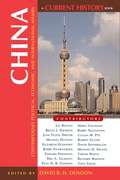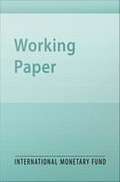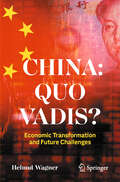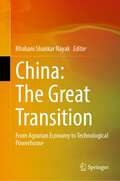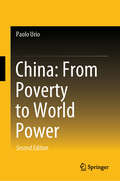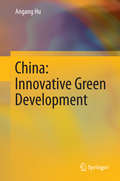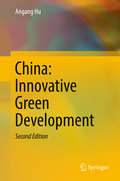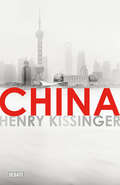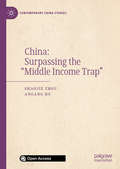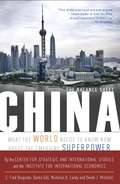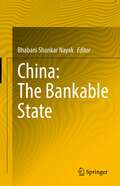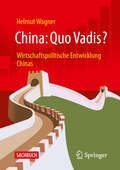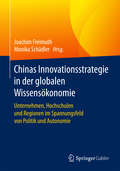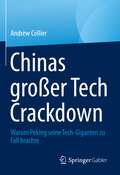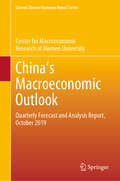- Table View
- List View
China: Contemporary Political, Economic, and International Affairs (Current History #2)
by David B. H. DenoonChina’s dramatic transformation over the past fifteen years has drawn its share of attention and fear from the global community and world leaders. Far from the inward-looking days of the Cultural Revolution, modern China today is the world’s fourth largest economy, with a net product larger than that of France and the United Kingdom. And China’s dynamism is by no means limited to its economy: enrollments in secondary and higher education are rapidly expanding, and new means of communication are vastly increasing information available to the Chinese public. In two decades, the Chinese government has also transformed its foreign relations—Beijing is now consulted on virtually every key development within the region. However, the Communist Party of China still dominates all aspects of political life. The Politburo is still self-selecting, Beijing chooses province governors, censorship is widespread, and treatment of dissidents remains harsh. In China, leading experts provide an overview of the region, highlighting key issues as they developed in the People’s Republic of China, Hong Kong, and Taiwan. Edited with an introduction by David B. H. Denoon, an authority on China, this volume of articles covers recent events and key issues in understanding this growing superpower. Organized into three thematic sections—foreign policy and national security, economic policy and social issues, and domestic politics and governance—the essays cover salient topics such as China's military power, de-communization, growing economic strength, nationalism, and the possibility for democracy. The volume also contains current maps as well as a “Recent Chronology of Events” which provides a decade's worth of information on the region, organized by year and by country.Contributors: Liu Binyan, David B.H. Denoon, Bruce J. Dickson, June Teufel Dreyer, Michael Dutton, Elizabeth Economy, Barry Eichengreen, Edward Friedman, Dru C. Gladney, Paul H. B. Godwin, Merle Goldman, Richard Madsen, Barry Naughton, Lucian W. Pye, Tony Saich, David Shambaugh, Robert Sutter, Michael D. Swaine, and Tyrene White.
China: Does Government Health and Education Spending Boost Consumption?
by Ray Brooks Steve BarnettA report from the International Monetary Fund.
China: Economic Reform and Macroeconomic Management
by Mario BlejerChina encountered problems preserving economic stability while pursuing reforms aimed at increasing its economic flexibility and efficiency. This paper examines China's experience with market-oriented reforms since 1978, offering lessons for other centrally planned economies in the midst of transition to free markets.
China: Economic Transformation and Future Challenges
by Helmut WagnerSince 1980, China has undergone an extraordinary economic transformation, rising from a relatively minor geopolitical player to a global economic superpower. However, in recent years, this meteoric growth has slowed, and the nation now faces a range of complex and pressing challenges. This book provides a comprehensive analysis of China’s remarkable ascent, exploring the pivotal reforms that fueled its rise and their far-reaching implications for both China and the West. While reflecting on this transformative journey, the primary focus is on the critical issues China faces today, including its slowing economic growth and escalating geopolitical tensions, particularly with the United States. Under the leadership of President Xi Jinping, China is responding to these challenges through a series of ambitious economic and political strategies. The book examines these approaches, offering insights into their potential effectiveness and limitations. Looking ahead, it explores possible political and economic scenarios for China in the coming years, shedding light on their implications for Western businesses and China’s own trajectory. This insightful and accessible work is essential reading for anyone seeking to understand China’s economic policies, challenges, and its role in shaping the global economy. Key Topics Covered: China’s journey to becoming a global economic powerhouse Xi Jinping’s economic policy strategies The critical economic and geopolitical challenges facing China Possible future scenarios and their implications for China and the world
China: Esquel Group and the Chinese Renminbi
by Laura Alfaro Rafael Di Tella Ingrid VogelIn July 2005, China revalued its currency by 2.1% and adjusted its exchange rate regime toward a more market-based system. Esquel Group, a family-run, privately held textiles firm specializing in high-quality cotton shirts with its most significant manufacturing base located in China, was among those companies confronted with the challenge of addressing the revaluation of the yuan and the possibility of future appreciation. Provides a brief overview of China's textile industry and background on Esquel Group.
China: Facing the 21st Century
by Robert E. Kennedy Katherine MarquisAfter 20 years of strong economic performance, economic czar Zhu Rongji considers whether it is time to rethink China's development strategy. The case reviews China's development strategy since 1978 and considers the challenges facing the country as it enters the 21st Century. Teaching purpose: To develop familiarity with China, its distinctive development strategy, and the immense challenges it faces in the next 10 years.
China: From Agrarian Economy to Technological Powerhouse
by Bhabani Shankar NayakThis book explores the great transition of China from a subsistence agrarian economy to a technologically driven economic powerhouse which reflects the achievements of the hardworking Chinese people. China continues to grow as the second largest economy of the world from 2010 onwards. It is going to be the largest economy in the world by putting US economy behind. The Chinese GDP has increased of 1,500 times from 1952. This book examines the transformation of China and its economic growth is neither miraculous nor a product of market economy. Further, this book states economic development in China as a product of political pursuit shaped by the Chinese people led by the Communist Party of China from 1921 onwards. China is not only the workshop of the world today but also works as the engine of global economic growth and recovery of crisis ridden global economy. This book also shows how phenomenal Chinese economic growth and development led to the significant fall of poverty in China.This book states that the prosperous transition in China continues to show features of combined and uneven development. This is evident as China has largest billionaires, but many people still live and practice subsistence economy. However, many Chinese do not have access to clean air, water, sanitation and dignified sources of livelihoods. This book shows the social, economic and political inequalities as hindrances to deepening of democratic and egalitarian development in China. This book states that the gender gap and widening gap between urban and rural China are twin serious challenges to progressive transformations in China. The Chinese state and government are trying to implement different policies and programmes to overcome these challenges.
China: From Poverty to World Power
by Paolo UrioThe second edition of this book (updated to February 24, 2024) presents a comprehensive evaluation of the strategy implemented by China to manage its modernization process. The author evaluates to what extent the economy has been developed, whether the imbalances due to the priority given to economic development have been corrected, and whether the improvements of science and technology have allowed China to develop world class high-tech sectors and a modern defence. Clearly, the end of the XX Century saw the fulfilment of Zhou En Lai ‘four modernizations’, i.e. the acquisition of power resources that fulfilled Mao’s proud 1949 statement: ‘we stood up’, thereby projecting China into the international arena as a re-emerging world power. The author insists on the fundamental difference between American and Chinese ideologies as the main drivers of their foreign policy, i.e., the extreme rigidity of the former compared to the remarkable flexibility and adaptability of the latter. He further explains the consequences of the increasingly aggressive American foreign policy, i.e. the US pretence to act as the leader of the existential struggle between ‘democracy and dictatorship’. This posture reached its apex during the Ukrainian and the Middle East crises, that unveiled the irreversible decline of the West, and have become two formidable accelerators of the transition from the unipolar world ‘América made’ to the multipolar world promoted by China, Russia and the BRICS.
China: Innovative Green Development
by Angang HuThis book is particularly concerned with China's path to green development and how it can be understood, exploring questions such as how the goal of Chinese-led green development can be achieved. The book provides systematic explanations of the theory of green development, exploring its background, its theoretical basis, the areas it covers, the stages it encompasses and the constraining and favorable factors involved. We see how humankind is at a period of transition from the traditional black industrial civilization to a modern green ecological civilization. The author gives a profound critique of the traditional Western model of development, provides a comprehensive analysis of the crisis and the opportunities presented by green development and depicts the grand goal of green modernization in a creative, bold, forward-looking manner. A three-step strategy to design and promote green development is proposed. Readers will discover why China must become an innovator, practitioner, and leader of green development, and how green planning is an important means to establish green development. The book explores how local governments can become green innovation practitioners, and how enterprises can become the main arena of green development. This book is a creative and innovative work that will appeal to scholars interested in the long-term development of humankind in general and China in particular. It also serves well as a green development textbook, presenting related scientific knowledge and important information for decision-making in a concise, easy-to-understand form.
China: Innovative Green Development
by Angang HuThis book is particularly concerned with China s path to green development and how it can be understood, exploring questions such as how the goal of Chinese-led green development can be achieved. The book provides systematic explanations of the theory of green development, exploring its background, its theoretical basis, the areas it covers, the stages it encompasses and the constraining and favorable factors involved. We see how humankind is at a period of transition from the traditional black industrial civilization to a modern green ecological civilization. The author gives a profound critique of the traditional Western model of development, provides a comprehensive analysis of the crisis and the opportunities presented by green development and depicts the grand goal of green modernization in a creative, bold, forward-looking manner. A three-step strategy to design and promote green development is proposed. Readers will discover why China must become an innovator, practitioner, and leader of green development, and how green planning is an important means to establish green development. The book explores how local governments can become green innovation practitioners, and how enterprises can become the main arena of green development. This book is a creative and innovative work that will appeal to scholars interested in the long-term development of humankind in general and China in particular. It also serves well as a green development textbook, presenting related scientific knowledge and important information for decision-making in a concise, easy-to-understand form. "
China: On China (Belfer Center Studies In International Security Ser.)
by Henry KissingerLa visión sobre China de una de las grandes figuras de la política internacional en la segunda mitad del siglo XX y Premio Nobel de la Paz. Cualquier intento de comprender el futuro papel de China en el mundo comienza con el reconocimiento de su historia: ningún otro país puede reivindicar una relación tan poderosa con su pasado y sus principios tradicionales, y son muy pocas las sociedades que han alcanzado una dimensión y una sofisticación comparables. Henry Kissinger fue el gran artífice de la apertura de China al mundo con su visita en 1971 como secretario de Estado, y la preparación de la que al año siguiente llevaría a cabo el presidente Nixon. Desde entonces, la relevancia de China en el mundo no ha dejado de crecer. Kissinger ha ayudado a configurar las relaciones de China con Occidente, y ha escrito por fin la historia de un país que conoce íntimamente. En este libro, Kissinger revisa los episodios clave de la política internacional china desde la época clásica hasta nuestros días y examina su estrategia diplomática en momentos tan fundamentales como los primeros encuentros entre el país asiático y las modernas potencias europeas, la creación y el colapso de la alianza chino-soviética, la guerra de Corea, el viaje histórico de Richard Nixon a Pekín y las tres crisis en el estrecho de Taiwán. Y, a partir de documentos históricos y de las conversaciones mantenidas con los líderes chinos durante los últimos cuarenta años, examina el modo en que China ha abordado la diplomacia, la estrategia y la negociación a lo largo de su historia, y reflexiona sobre sus consecuencias en el balance global del poder en el siglo XXI.
China: Surpassing the “Middle Income Trap” (Contemporary China Studies)
by Angang Hu Shaojie ZhouThis open access book explores one of the most fiercely debated issues in China: if and how China will surpass the middle income trap that has plagued many developing countries for years. This book gives readers a clear picture of China today and acts as a reference for other developing countries.China is facing many setbacks and experiencing an economic slowdown in recent years due to some serious issues, and income inequality is one such issue deferring China’s development potential by creating a middle income trap. This book thoroughly investigates both the unpromising factors and favorable conditions for China to overcome the trap. It illustrates that traps may be encountered at any stage of development and argues that political stability is the prerequisite to creating a favorable environment for economic development and addressing this “middle income trap”.Written by one of China's central planners, this book offers precious insights into the industrial policies that are transforming China and the world and will be of interest to China scholars, economists and political scientists.
China: The Balance Sheet
by C. Fred Bergsten Bates GillPut together by the Center for Strategic and International Studies and the Institute for International Economics, this volume examines the prospects for Chinese economic, political, and military developments from the perspective of US interests. Chapters address the Chinese domestic economy, the process of Chinese political transformation, the role of China in the world economy, and Chinese foreign and security policy in turn. Annotation ©2006 Book News, Inc. , Portland, OR (booknews. com)
China: The Balance Sheet
by C. Fred Bergsten Bates Gill Nicholas R. Lardy Derek MitchellChina's emergence as a major international power is perhaps the most important development in world affairs of the 21st century. Now, this book provides an indispensable survey of that country, the world's largest-- a vast land with 1.4 billion people and the world's most dynamic economy.Over the past year, Dr. Bates Gill, C. Fred Bergsten, Nicholas R. Lardy, and Derek Mitchell have led four task forces through a rigorous exercise of investigation and intelligence, compiling and analyzing the authoritative data on China's economy, foreign and domestic policy, and national security. Now that material has been shaped into an accessible narrative filled with facts, but written for the general reader. The expert judgements presented in China: The Balance Sheet will inform policymakers in Washintgon, scholars and the business community for years to come.
China: The Balance Sheet
by C. Fred Bergsten Bates GillChina's emergence as a major international power is perhaps the most important development in world affairs of the 21st century. Now, this book provides an indispensable survey of that country, the world's largest-- a vast land with 1. 4 billion people and the world's most dynamic economy. Over the past year, Dr. Bates Gill, C. Fred Bergsten, Nicholas R. Lardy, and Derek Mitchell have led four task forces through a rigorous exercise of investigation and intelligence, compiling and analyzing the authoritative data on China's economy, foreign and domestic policy, and national security. Now that material has been shaped into an accessible narrative filled with facts, but written for the general reader. The expert judgements presented in China: The Balance Sheet will inform policymakers in Washintgon, scholars and the business community for years to come.
China: The Bankable State
by Bhabani Shankar NayakThe volume on China: The Bankable State rejects neoliberal consensus and focuses on crucial contributions of the Chinese state in shaping Chinese economy. This book makes crucial theoretical contributions to the study of local political economy of China. This book engages with Chinese state responses to challenges China faces in the processes of reform, transition and development of both commercial and non-commercial banks.This book explores Chinese economic growth and development policy processes and its uniqueness in the wider world economy. The book examines Chinese financial policy praxis and offers an insightful account of its successes for the wider resurgence of alternative political economy of local development. Additionally, this book also showcases state led entrepreneurship in China.
China: Timeline of Changes Relevant to the Chinese Renminbi
by Laura Alfaro Rafael Di Tella Ingrid Vogel Renee Kim William RussellOn July 21, 2005 China revalued its decade-long quasi-fixed exchange rate of approximately 8.28 yuan per U.S. dollar by 2.1% to 8.11% and, at the same time, introduced a more market-based exchange rate system. Many analysts and economists were disappointed with what they considered too small a change and called for more flexibility in the U.S. dollar-yuan exchange rate. Provides a timeline of further changes relevant to the Chinese renminbi.
China: To Float or Not to Float? (A)
by Laura Alfaro Rafael Di Tella Ingrid VogelOn July 21, 2005 China revalued its decade-long quasi-fixed exchange rate of approximately 8.28 yuan per U.S. dollar by 2.1% to 8.11% and, at the same time, introduced a more market-based exchange rate system. Many analysts and economists were disappointed with what they considered too small a change and called for more flexibility in the U.S. dollar/yuan exchange rate. Modification to China's exchange rate regime had been eagerly anticipated and much debated in the preceding months as China's trade surplus against the United States reached record highs and as friction intensified with Europe and Japan. Also, analysts argued that the tightly managed exchange rate put a strain on China's own economy. Not only was the exchange rate expensive to sustain, but it contributed to--as well as limited China's flexibility in responding to--a potentially overheating economy. Although China's extensive controls on the movement of capital into the country helped to counteract some inflationary pressure, controls were becoming more porous as China increasingly integrated with the world economy. It remained to be seen what China would ultimately choose to do with its exchange rate regime.
China: Wirtschaftspolitische Entwicklung Chinas
by Helmut WagnerSeit 1980 hat China einen beispiellosen wirtschaftlichen Aufschwung erlebt. Doch in den letzten Jahren hat sich das Wachstum verlangsamt, und das Land steht vor zahlreichen gegenwärtigen und künftigen Herausforderungen. Dieses Buch beleuchtet Chinas Weg von einem geopolitisch unbedeutenden Land zur wirtschaftlichen Supermacht. Es analysiert die entscheidenden Reformen und deren Auswirkungen auf China und den Westen. Im Fokus stehen die aktuellen Probleme, wie das verlangsamte Wirtschaftswachstum und die geopolitischen Spannungen, insbesondere mit den USA. Es wird untersucht, wie China unter Präsident Xi Jinping auf diese Herausforderungen reagiert und welche wirtschaftspolitischen Strategien er verfolgt. Abschließend bietet das Buch einen Ausblick auf mögliche politische Entwicklungen Chinas in den nächsten Jahren und deren Auswirkungen auf westliche, insbesondere deutsche Unternehmen sowie auf Chinas eigenen wirtschaftlichen Fortschritt. Ein spannendes Werk für alle, die China und seine komplexe wirtschaftspolitische Entwicklung besser verstehen wollen.
Chinas Innovationsstrategie in der globalen Wissensökonomie
by Joachim Freimuth Monika SchädlerDieser Herausgeberband widmet sich der Transformation Chinas auf dem Wege zu einem nachhaltigen Entwicklungspfad. Der Fokus liegt darauf, eine auf Innovation und Wissen begründete Wachstumsstrategie zu entwickeln. Das stellt neue Anforderungen an Unternehmen, Hochschulen und Institutionen und an ihr Zusammenspiel. Die für innovatives Wachstum notwendige Autonomie der wirtschaftlichen und gesellschaftlichen Akteure steht jedoch im Widerspruch zum Steuerungsanspruch der Regierung. In diesem Konfliktfeld bewegt sich dennoch sehr viel und sehr schnell. Der Herausgeberband zeichnet diese vielfältigen Entwicklungen nach und berichtet über konkrete Erfahrungen von Unternehmen, Hochschulen und Beratern sowie aus originären Forschungen.
Chinas großer Tech Crackdown: Warum Peking seine Tech-Giganten zu Fall brachte
by Andrew CollierDieses Buch ist eine kurze Geschichte des chinesischen Vorgehens gegen die großen Technologieunternehmen des Landes, das im Jahr 2020 begann. Das Buch erörtert den politischen und wirtschaftlichen Kontext und zeigt die Grenzen der Macht des Staates auf. Da sich die Politik des "gemeinsamen Wohlstands" weiter entwickelt, wird dieses Buch ein unschätzbares Nachschlagewerk für Wirtschaftswissenschaftler sein, die sich entweder mit China, dem Internet und Big Tech oder beidem beschäftigen.
Chinaʼs Macroeconomic Outlook: Quarterly Forecast and Analysis Report, October 2019 (Current Chinese Economic Report Series)
by Center for Macroeconomic Research at XiaThis report is a partial result of the China’s Quarterly Macroeconomic Model (CQMM), a project developed and maintained by the Center for Macroeconomic Research (CMR) at Xiamen University. The CMR, one of the Key Research Institutes of Humanities and Social Sciences sponsored by the Ministry of Education of China, has been focusing on China’s economic forecast and macroeconomic policy analysis, and it started to develop the CQMM for purpose of short-term forecasting, policy analysis, and simulation in 2005.Based on the CQMM, the CMR and its partners hold press conferences to release forecasts for China’ major macroeconomic variables. Since July, 2006, twenty-six quarterly reports on China’s macroeconomic outlook have been presented and thirteen annual reports have been published. This 27th quarterly report has been presented at the Forum on China’s Macroeconomic Prospects and Press Conference of the CQMM at Xiamen University Malaysia on October 25, 2019. This conference was jointly held by Xiamen University and Economic Information Daily of Xinhua News Agency.
